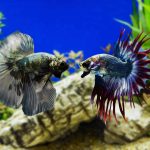Freshwater fish species often can be seen scavenging for algae growth on aquarium glass or nibbling at decorative aquatic plants, and many also provide waste removal, helping make their environment safer for tank mates.
Small bottom feeder tropical fish are easy to care for and make great additions to community tanks. Many are quite colorful as well!
Contents
Pleco
Plecos are commonly tank bred fish that can often be purchased at lower costs at your local fish store than wild caught specimens. These large, hardy species feed on algae while intaking high levels of phosphorus needed to build strong bones.
Although they are commonly sold as aquarium cleaners, this is only partially true. While they will eat some detritus and waste products from their environment, a well-balanced diet including plant matter (Aqueon Bottom Feeder Tablets), as well as protein sources like flake food or Repashy gel food is necessary for their wellbeing.
Bristlenose plecostomus are ideal for beginner hobbyists as they get along well with other passive community fish and are generally unaggressive. They enjoy living in well-planted tanks featuring caves and hiding spaces such as driftwood. Once adjusted, floating or sinking pellets, frozen bloodworms, or cucumber can be fed.
Zebra Loach
Zebra Loaches make an eye-catching addition to any aquarium. Their mazy stripes swooping backward and forward can be mesmerizing when seen from the side, especially.
These fish are exceptionally easy to care for. They thrive in tanks with fine sandy substrate and plenty of hiding places such as rocks, bogwood and plants. For optimal conditions their water should have an acidity between 6 – 7.5 pH and moderate hardness (around 2-10dKH).
Fish tend to be fairly intolerant of fluctuation in tank conditions; however, regular testing and partial water changes (25-30%) should help them remain happy and healthy. Catfish pellets should be fed daily alongside veggies like cucumbers, zucchinis and spinach for optimal nutrition.
Twig Catfish
Farlowella long-bodied fish possess remarkable camouflage abilities that mimic submerged sticks or branches to provide them with exceptional protection from predators in the wild.
Tankmates for corydoras catfish include hatchetfish, pencilfish and rasboras; boisterous species may not do as well at feeding time.
Twig Catfish are extremely sensitive to fluctuating water conditions and may quickly perish in poorly maintained tanks. Regular water changes and quality filtration systems are vital in order to keep these fish alive, and driftwood forms an integral part of their diet by helping scrape away algae and biofilm from surfaces – something the other fish don’t do themselves!
Yoyo Loach
These colorful fish add energy and activity to any tank. Often seen darting between hiding spots and open water, on average these species typically live 5-8 years, although experienced aquarists have witnessed some thriving for longer.
Yoyo Loaches thrive when kept in groups of five or six, to reduce fighting among their own species. They may also co-habitate well with small fish such as catfish, and smaller inverts such as snails.
Bottom feeders like to burrow into substrate during the day and nibble at algae at night. Their mouths feature four pairs of barbels that change colors for camouflage or stress relief or illness.
Suckermouth Catfish
Suckermouth catfish (Hypostomus plecostomus) is an attractive addition to tropical community fish tanks, often helping maintain water quality through its raspy mouth that grinds up algae and other organic materials for sustenance.
Bony Platefish have dense bony plates on their bodies that resemble armor and range in color from brown to tan with darker spots and stripes. Solitary by nature, this fish prefers aquariums of 75 gallons or greater as too small of an environment may lead to aggression from its inhabitants.
Provide this fish with both herbivorous and omnivorous food sources, including vegetable wafers that sink. Also feed algae and detritus from your tank substrate as food items; males can be identified from females by having a thick stub protruding from their undercarriage.




